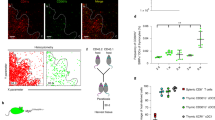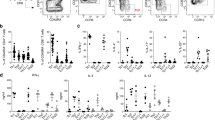Abstract
DENDRITIC cells comprise a system of highly efficient antigen-presenting cells which initiate immune responses such as the sensitization of T cells restricted by major histocompatibility complex molecules, the rejection of organ transplants and the formation of T-cell-dependent antibodies. Dendritic cells are found in many non-lymphoid tissues, such as skin (Langerhans cells) and mucosa, and they migrate after antigen capture through the afferent lymph or the bloodstream to lymphoid organs, where they efficiently present antigen to T cells1. Dendritic cells are difficult to isolate and, although they originate from bone marrow2,3 their site of maturation and the conditions that direct their growth and differentiation are still poorly characterized. Granulocyte macrophage-colony stimulating factor (GM-CSF) favours the outgrowth of dendritic cells from mouse peripheral blood4. Here we extend this finding to man and demonstrate that cooperation between GM-CSF and tumour necrosis factor-α (TNF-α) is crucial for the generation of human dendritic/Langerhans cells from CD34+ haematopoietic progenitors. The availability of large numbers of these cells should now facilitate the understanding of their role in immunological regulation and disorder.
This is a preview of subscription content, access via your institution
Access options
Subscribe to this journal
Receive 51 print issues and online access
$199.00 per year
only $3.90 per issue
Buy this article
- Purchase on Springer Link
- Instant access to full article PDF
Prices may be subject to local taxes which are calculated during checkout
Similar content being viewed by others
References
Steinman, R. M. A. Rev. Immun. 9, 271–296 (1991).
Steinman, R. M., Lustig, D. S. & Cohn, Z. A. J. exp. Med. 139, 1431–1445 (1974).
Katz, S. I., Tamaki, K. & Sachs, D. H. Nature 282, 324–326 (1979).
Inaba, K. et al. J. exp. Med. 175, 1157–1167 (1992).
Caux, C. et al. Blood 75, 2292–2298 (1990).
Caux, C. et al. Blood 78, 635–644 (1991).
van de Rijn, M. et al. Hum. Immun. 9, 201–210 (1984).
Van Voorhis, W. C. et al. J. exp. Med. 158, 171–191 (1983).
Crow, M. K. & Kunkel, H. G. Clin. exp. Immun. 49, 338–346 (1982).
Witmer-Pack, M. D., Olivier, W., Valinsky, J., Schuler, G. & Steinman, R. M. J. exp. Med. 166, 1484–1498 (1987).
Heufler, C., Koch, F. & Schuler, G. J. exp. Med. 167, 700–705 (1987).
Koch, F. et al. J. exp. Med. 171, 159–172 (1990).
Gabbianelli, M. et al. Science 249, 1561–1564 (1990).
Djeu, J. Y. in Tumour Necrosis Factors: The Molecules and Their Emerging Role in Medicine (ed. Beutler, B.) 531–537 (Raven, New York, 1992).
Metcalf, D. Science 254, 529–533 (1991).
Luger, T. A. Acta derm. venereol. 69, 61–76 (1989).
Malik, S. T. A. in Tumor Necrosis Factors: The Molecules and Their Emerging Role in Medicine (ed. Beutler, B.) 407–423 (Raven, New York, 1992).
Ghiara, P., Borascki, D., Neucroni, L., Ghezzi, P. & Toglabue, A. J. Immun. 139, 1753–1758 (1987).
Van Voorhis, W. C., Hair, L. S., Steinman, R. M. & Kaplan, G. J. exp. Med. 155, 1172–1187 (1982).
Freudenthal, P. S. & Steinman, R. M. Proc. natn. Acad. Sci. U.S.A. 87, 7698–7702 (1990).
Romani, N. et al. J. invest. Dermatol. 93, 600–609 (1989).
Knight, S. C., Macatonia, S. E., Bedford, P. A. & Patterson, S. in Accessory Cells in HIV and Other Retroviral Infections (eds Racz, P., Dijkstra, C. D. & Gluckman, J. C.) 145–154 (Karger, Basel, 1991).
Langhoff, E. et al. Proc. natn. Acad. SCi. U.S.A. 88, 7998–8002 (1991).
Tschachler, E. et al. J. invest. Dermatol. 88, 233–237 (1987).
Cameron, P. U. et al. Science 257, 383–387 (1992).
Sornasse, T. et al. J. exp. Med. 175, 15–21 (1992).
Dezutter-Dambuyant, C. et al Hybridoma 8, 199–208 (1989).
Dezutter-Dambuyant, C., Schmiktt, D., Faure, M., Horisberger, M. & Thivolet, J. J. invest. Derm. 84, 465–468 (1985).
Hart, D. N. J. & McKenzie, J. L. J. exp. Med. 168, 157–160 (1988).
Author information
Authors and Affiliations
Rights and permissions
About this article
Cite this article
Caux, C., Dezutter-Dambuyant, C., Schmitt, D. et al. GM-CSF and TNF-α cooperate in the generation of dendritic Langerhans cells. Nature 360, 258–261 (1992). https://doi.org/10.1038/360258a0
Received:
Accepted:
Issue Date:
DOI: https://doi.org/10.1038/360258a0
This article is cited by
-
Identification and characterization of stromal-like cells with CD207+/low CD1a+/low phenotype derived from histiocytic lesions – a perspective in vitro model for drug testing
BMC Cancer (2024)
-
Dendritic cells in cancer immunology
Cellular & Molecular Immunology (2022)
-
Cutaneous wound healing: canine allogeneic ASC therapy
Stem Cell Research & Therapy (2020)
-
Engineered niches support the development of human dendritic cells in humanized mice
Nature Communications (2020)
-
Highly efficient CRISPR-targeting of the murine Hipp11 intergenic region supports inducible human transgene expression
Molecular Biology Reports (2020)
Comments
By submitting a comment you agree to abide by our Terms and Community Guidelines. If you find something abusive or that does not comply with our terms or guidelines please flag it as inappropriate.



